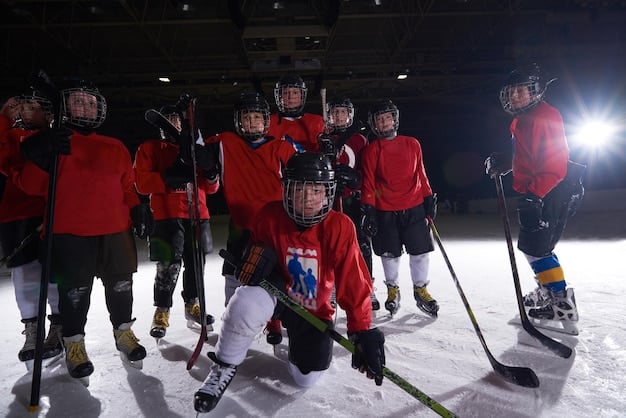The Financial Burden of Youth Hockey: Are Rising Costs Limiting Access?

The financial burden of youth hockey in the US is increasingly significant, with rising costs potentially limiting access for many families and creating barriers to participation in this popular sport.
The thrill of watching your child glide across the ice, the camaraderie of team sports, and the potential for scholarships—youth hockey promises a world of opportunity. But for many American families, the dream of youth hockey is becoming increasingly difficult to afford. The escalating costs associated with equipment, ice time, travel, and coaching are creating a significant financial burden of youth hockey: are rising costs limiting access for US families?
The Escalating Costs of Youth Hockey
Youth hockey, once considered a niche sport, has surged in popularity across the United States. However, this growth has been accompanied by a steep increase in expenses, making it a considerable financial undertaking for families.
Understanding the comprehensive costs involved is the first step in assessing the true financial burden.
Equipment Expenses
One of the most significant upfront costs in youth hockey is equipment. Unlike some sports that require minimal gear, hockey necessitates a full set of protective equipment to ensure player safety.
From helmets and pads to skates and sticks, the expenses quickly add up.
- Helmets: High-quality helmets can range from $100 to $300, essential for protecting against head injuries.
- Pads: Shoulder, elbow, and knee pads are crucial for safety, costing between $200 and $500 collectively.
- Skates: Skates can range from $150 for beginners to $800 or more for advanced players.
- Sticks: Hockey sticks need to be replaced regularly and can vary in price from $50 to $250 each.
These costs can be particularly burdensome for families with multiple children participating in the sport or for those on a tight budget.
Ice Time and Training Fees
Beyond the initial equipment expenses, ongoing costs such as ice time and training fees contribute significantly to the financial strain on families.
These expenses are essential for player development but can quickly become prohibitive.
Ice Time Costs
Ice time is a fundamental requirement for practicing and playing hockey. Rental fees for ice rinks can be substantial, especially in densely populated areas where demand is high.
Teams often need to secure several hours of ice time per week for practices and games, leading to considerable costs.
- Practice Ice: Hourly rates for practice ice can range from $200 to $500, depending on the location and time of day.
- Game Ice: Securing ice time for games can be even more expensive, potentially costing several hundred dollars per game.
These fees are often passed on to families through team dues, making it crucial for parents to budget accordingly.

Professional Coaching and Training
Many young hockey players seek additional coaching and training to enhance their skills and improve their performance. Private lessons, skill clinics, and specialized camps can provide valuable instruction but come at a premium price.
Families often invest in these resources to give their children a competitive edge.
- Private Lessons: Individual coaching sessions can range from $50 to $150 per hour.
- Skill Clinics: Weekend clinics focusing on specific skills can cost between $100 and $300.
- Specialized Camps: Summer hockey camps, often lasting a week or more, can cost several hundred to several thousand dollars.
While these investments can be beneficial, they add another layer to the financial burden of youth hockey.
In summary, the combination of equipment, ice time, and training fees creates a substantial financial commitment for families involved in youth hockey.
Travel Expenses and Tournament Fees
As young hockey players progress, participation in tournaments and travel teams becomes increasingly common, which introduces a new set of financial challenges.
Travel expenses and tournament fees can quickly escalate, making it difficult for some families to keep up.
Travel Team Commitments
Travel teams often require extensive travel to compete in leagues and tournaments located across the region or even the country. These teams typically participate in multiple tournaments per season, each requiring travel, lodging, and meal expenses.
Families must budget for these costs in addition to regular team dues.
- Transportation: Airfare, gas, and car rentals can be significant expenses, especially for tournaments located far from home.
- Lodging: Hotel costs can add up quickly, with families often needing to stay for several nights during tournaments.
- Meals: Eating out can be expensive, and families must factor in the cost of meals for players and accompanying family members.
Travel team commitments can place a considerable financial strain on families, potentially excluding those with limited resources.
Tournament Entry Fees
In addition to travel expenses, tournament entry fees can also be quite costly. These fees cover the cost of ice time, referees, and awards, and they are typically paid per tournament.
Depending on the level and location of the tournament, entry fees can range from a few hundred to over a thousand dollars.
- Local Tournaments: Entry fees for local tournaments may range from $300 to $700.
- Regional Tournaments: Entry fees for regional tournaments can be higher, ranging from $800 to $1,200.
- National Tournaments: Entry fees for prestigious national tournaments can exceed $1,500.
These fees, combined with travel expenses, can make participating in tournaments a significant financial burden for many families.
Participating in tournaments and travel teams introduces a new level of financial commitment, which must be carefully considered by families.

Fundraising and Sponsorships
Recognizing the financial challenges faced by many families, youth hockey organizations often engage in fundraising activities to help offset costs. Additionally, some players may seek sponsorships to support their hockey endeavors.
These efforts can provide valuable financial assistance and make the sport more accessible.
Team Fundraising Initiatives
Many youth hockey teams and organizations organize fundraising events to raise money for equipment, ice time, and travel expenses. These initiatives can range from simple bake sales to more elaborate events such as car washes, raffles, and charity auctions.
The funds raised through these efforts can help reduce the financial burden on individual families.
- Bake Sales: Simple bake sales can generate modest funds while fostering team spirit.
- Car Washes: Car washes are a popular fundraising activity, particularly during the warmer months.
- Raffles: Raffles offer the chance to win prizes, attracting broad participation.
- Charity Auctions: More elaborate charity auctions can raise significant funds through the sale of donated items and experiences.
Team fundraising initiatives can provide important financial support and encourage community involvement.
Seeking Sponsorship Opportunities
Some young hockey players and their families actively seek sponsorships from local businesses and individuals to help offset hockey-related expenses. Sponsorships can provide financial assistance in exchange for promoting the sponsor’s brand.
Players may wear sponsor logos on their jerseys or equipment, or they may participate in promotional events.
- Local Businesses: Local businesses often support youth sports teams as a way to give back to the community.
- Individual Sponsors: Friends, family members, and hockey enthusiasts may be willing to provide financial support.
Securing sponsorships requires effort and networking, but it can provide valuable financial assistance for young hockey players.
Fundraising and sponsorships can play a significant role in alleviating the financial burden of youth hockey and promoting greater access to the sport.
Impact on Family Finances
The financial demands of youth hockey can have a significant impact on family budgets, requiring careful planning and prioritization.
For some families, the costs may be manageable, while for others, they can create considerable financial strain.
Budgeting Challenges
Families involved in youth hockey often face budgeting challenges as they try to balance hockey-related expenses with other household needs. The costs can be unpredictable, with unexpected equipment repairs or additional travel expenses arising throughout the season.
Careful budgeting and financial planning are essential for managing these expenses.
- Creating a Budget: Developing a detailed budget that accounts for all hockey-related expenses can help families track their spending and identify potential areas for savings.
- Prioritizing Expenses: Families may need to prioritize hockey expenses over other discretionary spending to ensure they can afford to participate in the sport.
- Seeking Financial Assistance: Exploring fundraising opportunities, sponsorships, and financial aid programs can help alleviate the financial burden.
Effective budgeting strategies can help families navigate the financial demands of youth hockey.
Opportunity Costs
In addition to the direct costs of youth hockey, families must also consider the indirect costs, or opportunity costs, associated with the sport. These may include the time and effort required to transport players to practices and games, attend tournaments, and participate in fundraising activities.
These commitments can take a toll on family time and resources.
- Time Commitment: The time required to support a young hockey player can be substantial, potentially impacting other family activities and responsibilities.
- Parental Involvement: Parents often need to dedicate significant time to coaching, managing, and supporting their child’s hockey endeavors.
- Financial Trade-offs: Families may need to make financial trade-offs, such as postponing vacations or reducing other expenses, to afford youth hockey.
Considering the opportunity costs of youth hockey is an important part of assessing the overall financial impact on families.
The financial demands of youth hockey can present significant budgeting challenges for families, requiring careful planning and resource management.
Strategies for Reducing Costs
While youth hockey can be expensive, there are several strategies families can employ to reduce costs and make the sport more affordable.
These strategies range from buying used equipment to participating in cost-sharing arrangements and seeking financial assistance.
Buying Used Equipment
One way to save money on youth hockey is to purchase used equipment. Many sporting goods stores and online marketplaces offer a selection of used hockey gear at discounted prices. Used equipment can provides an affordable alternative to buying new equipment, especially for growing players who may outgrow their gear quickly.
- Thrift Stores: Local thrift stores often have a selection of used hockey equipment.
- Online Marketplaces: Online marketplaces such as Craigslist and eBay can offer a wide range of used gear at competitive prices.
- Team Swaps: Many youth hockey teams organize equipment swaps where players can buy, sell, or trade used gear.
Cost-Sharing Arrangements
Families can also reduce costs by participating in cost-sharing arrangements with other hockey families. This can involve carpooling to practices and games, sharing equipment, or jointly hiring coaches and trainers.
- Carpooling: Sharing transportation responsibilities can reduce gas and mileage expenses.
- Equipment Sharing: Sharing equipment among players can help reduce the overall cost of gear.
- Shared Coaching: Hiring a private coach or trainer jointly with other families can make professional instruction more affordable.
Financial Assistance and Scholarships
Families facing financial hardship may be eligible for financial assistance and scholarships through youth hockey organizations and charitable foundations. These programs can provide financial support for equipment, ice time, and travel expenses.
- Local Hockey Associations: Local hockey associations often offer financial assistance programs to families in need.
- National Organizations: National organizations such as USA Hockey provide scholarships and grants to support young players.
- Charitable Foundations: Several charitable foundations focus on supporting youth sports, including hockey.
By implementing these cost-reduction strategies, families can make youth hockey more affordable and accessible for their children.
| Key Aspect | Brief Overview |
|---|---|
| 💰 Costs Overview | Equipment, ice time, travel, and coaching fees make up the bulk of youth hockey expenses. |
| 🏒 Financial Impact | Youth hockey costs can strain family budgets, requiring sacrifices in other areas. |
| 🤝 Fundraising Efforts | Team fundraising initiatives and seeking sponsorships can alleviate financial burdens. |
| 📉 Cost-Saving Tips | Buying used gear, cost-sharing, and financial aid can make youth hockey more affordable. |
Frequently Asked Questions
▼
The primary costs include equipment, ice time rental, coaching fees, travel expenses for tournaments, and team dues, all contributing to the financial burden.
▼
Consider purchasing used equipment from thrift stores, online marketplaces, or team swaps. These options offer significant savings without compromising safety.
▼
Yes, many local hockey associations and national organizations like USA Hockey offer financial assistance and scholarships to families in need.
▼
Create a detailed budget outlining all anticipated hockey-related costs. Prioritize these expenses and seek ways to cut back on discretionary spending to manage the budget.
▼
Team fundraising efforts, such as bake sales and car washes, raise money for equipment, ice time, and travel expenses, reducing the financial load on each family.
Conclusion
In conclusion, the financial demands of youth hockey in the US can be considerable, potentially limiting access for many families. However, by understanding the costs involved, exploring cost-reduction strategies, and seeking financial assistance, families can work towards making the sport more accessible for their children.





